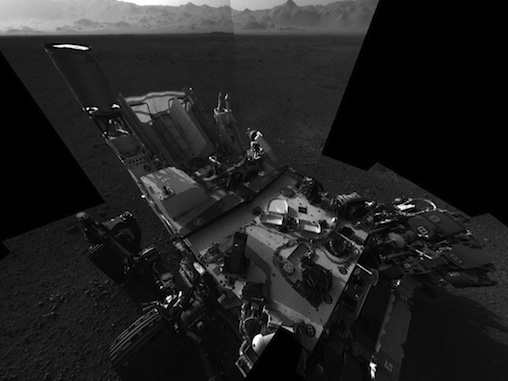With the Mars Curiosity rover's science instruments working well, NASA engineers are getting ready for two big tests of their robotic rover -- blasting a rock with a laser beam and getting the rover moving.
Curiosity's first drive will be a very short one. Before the rover starts any meaningful trek across the Martian surface, scientists will first simply drive it forward and back in the landing area, to test the wheels and motor system, according to John Grotzinger, a project scientist with NASA's Jet Propulsion Laboratory and a geology professor at the California Institute of Technology.

This full-resolution self-portrait shows the deck of NASA's Curiosity rover from the rover's Navigation camera. The back of the rover can be seen at the top left, and two of the rover's right side wheels can be seen on the left. The undulating rim of Gale Crater forms the lighter color strip in the background. Bits of gravel, about 0.4 inches (1 centimeter) in size, are visible on the deck of the rover. (Photo: NASA/JPL-Caltech)
"The excitement from the science team is that all the instruments continue to check out," he said during a press call Friday. "If we continue down the nominal path, it's probably going to be a couple of days. Sometime next week you'll hear about successful tests of the first wheel motions."
Once the wheels are successfully tested, scientists will continue to plot out Curiosity's first real trek, which will take it west toward an area NASA has dubbed Glenelg.
"The Glenelg area -- it simply looks distinctive and interesting," said Grotzinger. "It looks cool. Let's go there and see what's there."
It is expected to take the rover three to four weeks to reach Glenelg unless the rover encounters rocks or soil that scientists want it to stop and analyze. Once it reaches its first destination, Grotzinger said the rover will probably spend about two months analyzing that area.
Toward the end of the year, NASA engineers will begin to have Curiosity move toward Mount Sharp, a three-mile high mountain in the middle of Gale Crater, where the rover landed. Mount Sharp is a primary area of interest for the scientists who are hoping to discover if Mars has ever been able to support microbial life.
However, before the rover begins heading to Glenelg, scientists want to test its laser.
The laser, which is situated on top of the rover's mast, is designed to break up rocks. The rover's instruments will then analyze the resulting dust and vapor to see if the rock is interesting enough to study up close.
To test it, scientists will instruct the rover to blast a rock just a few feet away from it, according to Roger Wiens, a scientist with the Los Alamos National Laboratory and a lead investigator on the Curiosity team.
Wiens explained that the laser will hit the rock with 30 pulses in the course of 10 seconds. "Each time we shoot the laser, we'll take an image of the plasma," he said. "As the laser burns through the dust, we'll look for any surface effects."
The rock itself is merely a target.
"We didn't pick it for its science value," said Wiens. "We're just using it for target practice. We wanted to shoot something that is sort of mid-range for a first shot. We thought we'd give ourselves something easy to start with."
Despite the rock being an easy target, scientists will still analyze it and add it to what they hope will be a burgeoning stock pile of new information about Mars.
"This laser breakdown might tell us something of the coating on the rock, which could tell us about the weather or what's happened to the rock over the eons," said Wiens, adding that the rock appears to be a "typical Mars basalt," similar to the ones largely found on the Earth's ocean floor. "Maybe we'll also see possibly some absorbed hydrogen, which could tell us about microscopic interactions on the surface of Mars."
Curiosity, NASA's super robotic rover, has been on the surface of Mars for about a week and a half.
The car-sized, nuclear-powered robotic rover is on what NASA hopes will be at least a two-year mission. It is equipped with 10 scientific instruments and offers the most advanced payload of scientific gear ever used on the surface of Mars, including chemistry instruments, environmental sensors and radiation monitors.





